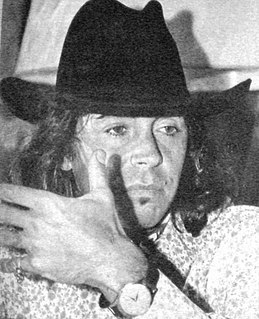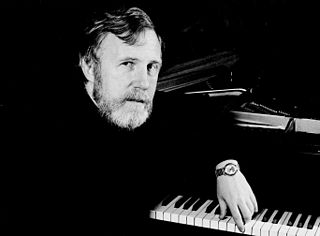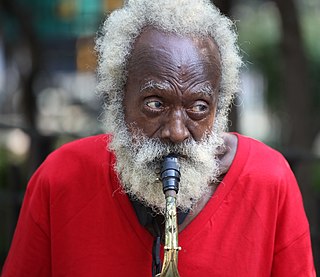 W
WAlbert Ayler was an American avant-garde jazz saxophonist, singer and composer.
 W
WLeandro "Gato" Barbieri was an Argentine jazz tenor saxophonist who rose to fame during the free jazz movement in the 1960s and is known for his Latin jazz recordings of the 1970s. His nickname, Gato, is Spanish for "cat".
 W
WRan Blake is an American pianist, composer, and educator. He is known for his unique style that combines blues, gospel, classical, and film noir influences into an innovative and dark jazz sound. His career spans over 40 recording credits on jazz albums along with more than 40 years of teaching jazz at the New England Conservatory of Music, where he started the Department of Third Stream with Gunther Schuller.
 W
WPaul Bley, CM was a jazz pianist known for his contributions to the free jazz movement of the 1960s as well as his innovations and influence on trio playing and his early live performance on the Moog and Arp audio synthesizers. His music has been described by Ben Ratliff of the New York Times as "deeply original and aesthetically aggressive". Bley's prolific output includes influential recordings from the 1950s through to his solo piano recordings of the 2000s.
 W
WMarion Brown was an American jazz alto saxophonist, composer, writer, visual artist, and ethnomusicologist. He was a member of the avant-garde jazz scene in New York City during the 1960s, playing alongside musicians such as John Coltrane, Archie Shepp, and John Tchicai. He performed on Coltrane's landmark 1965 album Ascension. AllMusic reviewer Scott Yanow described him as "one of the brightest and most lyrical voices of the 1960s avant-garde."
 W
WWilliam Seward Burroughs II was an American writer and visual artist, credited as a primary figure of the Beat Generation and a major postmodern author who influenced popular culture and literature. Burroughs wrote eighteen novels and novellas, six collections of short stories and four collections of essays, and five books have been published of his interviews and correspondences. He also collaborated on projects and recordings with numerous performers and musicians and made many appearances in films. He was also briefly known by the pen name William Lee. Burroughs created and exhibited thousands of paintings and other visual artworks, including his celebrated 'Shotgun Art'.
 W
WRandolph Denard Ornette Coleman was an American jazz saxophonist, violinist, trumpeter, and composer known as a principal founder of the free jazz genre, a term derived from his 1960 album Free Jazz: A Collective Improvisation. His pioneering performances often abandoned the chordal and harmony-based structure found in bebop, instead emphasizing a jarring and avant-garde approach to improvisation.
 W
WJayne Rogers, better known by her stage name Jayne County is an American singer, songwriter, actress and record producer whose career has spanned six decades. Under the name Wayne County, she was the vocalist of influential proto-punk band Wayne County & the Electric Chairs who became known for their campy and foul-mouthed ballads, glam punk inspired songs, and image which was heavily influenced by Jackie Curtis and the Theatre of the Ridiculous. County in particular was known for her outrageous and unpredictable stage antics as well as possessing a distinctive singing voice. She went on to become rock's first openly transgender singer, and adopted the stage name Jayne County.
 W
WCromagnon was an American experimental music band that was active during the late 1960s. Led by multi-instrumentalist singer-songwriters Austin Grasmere and Brian Elliot, the band's only release was the album Orgasm in 1969, which was later reissued as Cave Rock. They are said to have foreshadowed the rise of noise rock, no wave, industrial and industrial rock. While the band was not commercially notable or successful, Pitchfork Media ranked their song "Caledonia", later covered by the Japanese experimental band Ghost, at number 163 on their list of "The 200 Greatest Songs of the 1960s".
 W
WHamid Drake is an American jazz drummer and percussionist.
 W
WThe Fugs are an American band formed in New York City in late 1964, by the poets Ed Sanders and Tuli Kupferberg, with Ken Weaver on drums. Soon afterward, they were joined by Peter Stampfel and Steve Weber of The Holy Modal Rounders. Kupferberg named the band from a euphemism for fuck used in Norman Mailer's novel The Naked and the Dead.
 W
WMilford Graves was an American jazz drummer, percussionist, Professor Emeritus of Music, researcher/inventor, visual artist/sculptor, gardener/herbalist, and martial artist. Graves was noteworthy for his early avant-garde contributions in the 1960s with Paul Bley, Albert Ayler, and the New York Art Quartet, and is considered to be a free jazz pioneer, liberating percussion from its timekeeping role. The composer and saxophonist John Zorn referred to Graves as "basically a 20th-century shaman."
 W
WBurton Greene was an American free jazz pianist born in Chicago, Illinois, though most known for his work in New York City. He explored multiple genres, including avant-garde jazz and the Klezmer medium.
 W
WGunter Hampel is a German jazz vibraphonist, clarinettist, saxophonist, flautist, pianist, and composer. He became dedicated to free jazz in the 1960s, developing a record label and working with John McLaughlin, Muruga Booker, Laurie Allan, Udo Lindenberg, Pierre Courbois, Archie Shepp, Marion Brown, Steve McCall and Perry Robinson. In 1972, he formed the Galaxie Dream Band.
 W
WNoah Howard was an American free jazz alto saxophonist.
 W
WRobert McElhiney James, known professionally as Bob James, is an American jazz keyboardist, arranger, and record producer. He founded the band Fourplay and wrote "Angela", the theme song for the TV show Taxi. Music from his first seven albums has often been sampled and has contributed to the formation of hip hop. Among his most well known recordings are "Nautilus", "Westchester Lady", "Tappan Zee", and his version of "Take Me to The Mardi Gras".
 W
WNaphtali "Tuli" Kupferberg was an American counterculture poet, author, singer, cartoonist, pacifist anarchist, publisher, and co-founder of the band The Fugs.
 W
WSteve Lacy, born Steven Norman Lackritz in New York City, was an American jazz saxophonist and composer recognized as one of the important players of soprano saxophone. Coming to prominence in the 1950s as a progressive dixieland musician, Lacy went on to a long and prolific career. He worked extensively in experimental jazz and to a lesser extent in free improvisation, but Lacy's music was typically melodic and tightly-structured. Lacy also became a highly distinctive composer, with compositions often built out of little more than a single questioning phrase, repeated several times.
 W
WTimothy Francis Leary was an American psychologist and writer known for his strong advocacy of psychedelic drugs. Evaluations of Leary are polarized, ranging from bold oracle to publicity hound. He was "a hero of American consciousness", according to Allen Ginsberg, and Tom Robbins called him a "brave neuronaut."
 W
WPeter Naphtali Lemer is an English jazz musician. He worked with the Pete Lemer Quintet, Spontaneous Music Ensemble, Annette Peacock, Harry Beckett, Gilgamesh, Baker Gurvitz Army, Seventh Wave, Harry Beckett's Joy Unlimited, Pierre Moerlen's Gong, Mike Oldfield Group, In Cahoots, Miller/Baker/Lemer. He currently works with In Cahoots, Peter Lemer Trio/Quartet, Barbara Thompson's Paraphernalia, and the Peter Lemer-Billy Thompson Quartet and Duo.
 W
WGiuseppi Logan was a jazz musician, originally from Philadelphia, Pennsylvania, who taught himself to play piano and drums before switching to reeds at the age of 12. At the age of 15 he began playing with Earl Bostic and later studied at the New England Conservatory. In 1964 he relocated to New York and became active in the free jazz scene.
 W
WFrank Lowe was an American avant-garde jazz saxophonist and composer.
 W
WJames Marcellus Arthur "Sunny" Murray was one of the pioneers of the free jazz style of drumming.
 W
WEarl Rudolph "Bud" Powell was an American jazz pianist and composer. Along with Charlie Parker, Thelonious Monk, and Dizzy Gillespie, Powell was a leading figure in the development of modern jazz. His virtuosity led many to call him the Charlie Parker of the piano. Powell was also a composer, and many jazz critics credit his works and his playing as having "greatly extended the range of jazz harmony".
 W
WPerry Morris Robinson > was an American jazz clarinetist and composer. He was the son of composer Earl Robinson.
 W
WPharoah Sanders is an American jazz saxophonist. A member of John Coltrane's groups of the mid-1960s, Sanders is known for his overblowing, harmonic, and multiphonic techniques on the saxophone, as well as his use of "sheets of sound". He has released over 30 albums as a leader and has collaborated extensively with Leon Thomas, Alice Coltrane and Rinai Maurice, among others. Saxophonist Ornette Coleman described him as "probably the best tenor player in the world".
 W
WAlan Silva is an American free jazz double bassist and keyboard player.
 W
WHuey "Sonny" Simmons was an American jazz musician.
 W
WLe Sony'r Ra, better known as Sun Ra, was an American jazz composer, bandleader, piano and synthesizer player, and poet known for his experimental music, "cosmic" philosophy, prolific output, and theatrical performances. For much of his career, Ra led "The Arkestra," an ensemble with an ever-changing name and flexible line-up.
 W
WKarel Velebný was a Czech jazz musician, composer, arranger, actor, writer and music pedagogue. Velebný was one of the founders of modern Czech jazz in the second half of the 20th century.